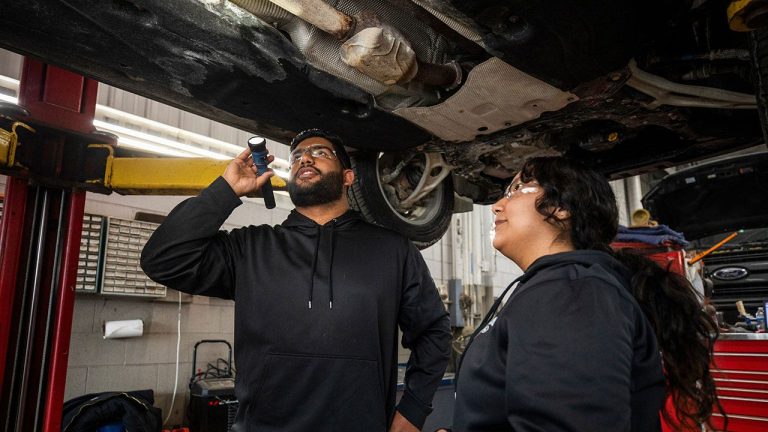

During the height of the pandemic, schools sent kids home if they had a sore throat, cough, headache or any potential COVID-19 symptom and told them to stay home for as long as two weeks if they came in contact with someone with COVID.
But California’s state of emergency is long gone, while high numbers of students are missing school and falling behind grade level. So schools have reversed course — now school and health officials say kids can still come to school even if they’re showing mild respiratory symptoms or if they have been exposed to COVID, provided they don’t have it themselves.
The state health department released detailed new guidance earlier this month that outlines under what circumstances a student should stay home from school or child care.
In general, a student can come to school as long as their symptoms don’t prevent them from being able to “meaningfully participate” in school or child care. Students should also stay home if their condition requires a degree of care from school staff that would compromise other students’ health or safety, the guidance says.
The guidance recommends students with respiratory symptoms wear masks to help prevent spread.
The guidance details which scenarios and symptoms are considered more severe — including a fever, trouble breathing and recurring vomiting — and mean a student shouldn’t go to school. And general state health guidance still says anyone who tests positive for COVID should isolate at home for at least five days after symptom onset.
The change in state guidance comes as schools are trying to reduce student chronic absenteeism rates, which rose sharply after the onset of the pandemic. Last school year, almost one out of four public school students in San Diego County were chronically absent, compared to 11 percent of students before the pandemic.
The public health risk from COVID has declined as hospitalizations and deaths have fallen significantly, said John Bradley, the director of the infectious diseases division at Rady Children’s Hospital. Meanwhile the educational and social health risks of children not being in school have become much more prominent, he added.
“The fear that we all had that if a child with COVID got into the school, it would lead to hospitalization and death of adults — that’s no longer driving policy,” Bradley said. “The priority has shifted from saving lives to educating children.”
There are also many families who aren’t able to take time off work and stay home with their kids every time they, say, get a runny nose, said Davey Smith, an infectious disease specialist at UC San Diego. “It’s all risk and benefit. We still need kids to go to school.”
Some education officials said they have come to realize that strict COVID-era school health protocols, intended to reduce COVID spread during a state of emergency, have had the unintended effect of keeping kids away from school more often than is now considered necessary.
Not all parents know yet that they don’t have to follow strict quarantine and isolation protocols anymore, which has contributed to student absenteeism, said Tracy Schmidt, director of attendance, safety and student engagement at the San Diego County Office of Education.
That’s a problem because if students miss many days of school, they are missing out on the benefits that schools can provide for students, not just learning but emotional support, social development and physical security.
“We started coming to the realization that our health practices were inadvertently contributing to our crisis of chronic absenteeism,” Schmidt said. “Our focus at this point needs to shift away from … keeping our students out and instead do everything we can to have them be in school.”
Before the pandemic, schools tended to focus more on reducing so-called unexcused absences, or truancy, Schmidt said. Now they are increasingly turning attention to excused absences, which include absences due to illness or medical appointments.
Just because these absences are excused doesn’t necessarily mean they should be treated as alright, said Todd Langager from the county education office who oversees a countywide effort to reduce absenteeism. Excessive absences, regardless of the reason, keep kids away from school.
So part of schools’ work in combating chronic absenteeism, Langager said, has been getting the word out to parents that they no longer have to follow the strict protocols of the past three years.
“COVID is out there just like the flu. As long as you’re not presenting certain symptoms, we really want your son or daughter to be at school,” Langager said. “Schools are really trying to reinforce those messages again.”
Parents who are unsure about whether to keep their child home should talk with their school’s staff, Schmidt said. And if a parent suspects their child may have COVID, they should still have them tested promptly, Bradley said. Some schools offer free at-home tests for families.
The guidance does not eliminate chances that diseases can be spread at school but rather should be part of schools’ larger strategies to minimize spread, state health officials said. Those strategies include ensuring high air quality, surface cleaning, washing hands and staying up to date on vaccinations.
Smith recommends that if students catch a respiratory illness, like a cold, they should stay home from school in the first couple of days of symptoms. That can significantly reduce the chances of spread, because people are often most contagious in the initial days of illness, he said.
“Keeping a kid home for two days at the beginning can be really advantageous … versus keeping them out the whole time. Maybe your benefit for decreasing infection is quite high, but you start risking the educational opportunity for that kid,” Smith said.
State officials say their guidance does not override advice from healthcare professionals, students’ medical or disability plans or recommendations on addressing specific diagnoses.
The guidance has been endorsed by the American Academy of Pediatrics in California, the California School Nurses Organization and the California Association of Communicable Disease Controllers, state officials said.






